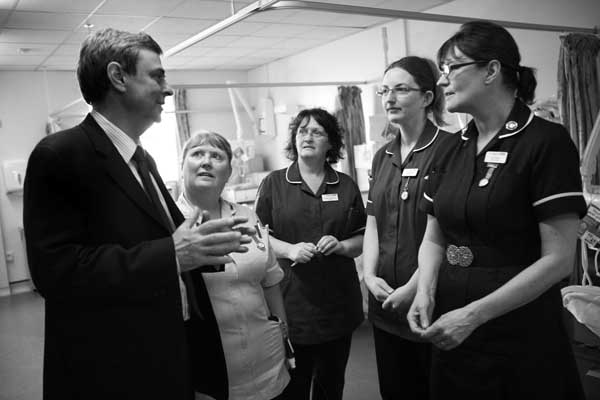Monitor, the Care Quality Commission, NHS Litigation Authority or the National Commissioning Board in all its iterations can’t inspect quality in the NHS at a distance...
Only health service workers can be the custodians of quality
WORKERS, SEP 2013 ISSUE
AFTER THE Francis Report into North Staffordshire General Hospital was published Workers pointed out that only one group of people can put right the quality of care in hospitals – we who work in the NHS. We must take responsibility for this, not abrogate it as we have done with our pay and pensions. Monitor, the Care Quality Commission, NHS Litigation Authority or the National Commissioning Board in all its iterations can’t inspect quality in the service at a distance. We are the custodians, and a good starting point would be to take ownership of the “8 Ambitions” that came out of the review into the quality of care provided by 14 hospital trusts in England led by the National Medical Director, Professor Bruce Keogh. It is an excellent report and we commend it to you.

Only health workers can ensure good standards of care. Above: Unison general secretary Dave Prentis talking to union members at Mid-Staffordshire General Hospital.
Photo: John Harris/reportdigital.co.uk
Pockets of good practice were found in all 14 of the trusts reviewed alongside major deficiencies to be addressed. Keogh has ensured the public are now not just informed participants in a particular process but active assessors and regulators of the NHS. This represents a turning point in our health system from which there must be no return.
He concluded that over 90 per cent of deaths in these hospitals happen when patients are admitted in an emergency. Workforce issues included high rates of sickness absence and a heavy reliance on agency staff to compensate for large numbers of vacant posts, particularly among doctors and nurses. Inadequate numbers of trained nursing staff were frequently cited in certain ward areas.
Pressures
The main challenge in A&E Units resulted from pressures generated by the large increases in the numbers of elderly patients with complex and multifactorial problems who have diminishing access to care in the community. One of the primary causes of high mortality rates in these 14 hospitals was related to the provision of urgent and emergency care for older people. Five of the organisations have had medical staff training removed from the organisation by the General Medical Council because they were unable to meet the required standards.
The 14 trusts were reviewed on the basis that for the past two consecutive years they were statistical outliers on either the Summary Hospital Level Mortality Index (SHMI) or the Hospital Standardised Mortality Ratio (HSMR). But as Robert Francis (the QC who chaired the public inquiry into the Stafford hospital deaths) said, the use of HSMR and SHMI measures to quantify actual numbers of avoidable deaths is “misleading and a potential misuse of figures to extrapolate from them a conclusion that any particular range of numbers of deaths were caused by inadequate care”. A study has now been commissioned to determine the relationship between excess mortality rates and actual avoidable deaths. Jeremy Hunt, the Secretary of State for Health, should await the outcome of it.
It is time for a considered debate, not one fuelled by gratuitous assertions aimed at securing a Parliamentary majority in 2015. And not one led by the current Health Secretary, who for example in January this year authorised the sale of our 80 per cent stake in the blood products company Plasma Resources. This company, which supplies the NHS with treatments for haemophilia and immune deficiency, is now controlled by Bain Capital, a US private equity firm with no shareholders or public accountability.
Between 2000 and 2010 the NHS was rightly focused on rebuilding capacity and improving access after decades of Thatcherite neglect. The key issue then was not whether people were dying in our hospitals avoidably but dying while waiting for treatment.
Spending on the NHS more than doubled in revenue terms from £40 billion to over £100 billion a year. We witnessed the biggest capital modernisation and building programme ever seen in the history of the service – but PFI-driven, lining the pockets of private companies and leading to the huge unsustainable debts crippling the trusts today.
High performance
Waiting lists and waiting times fell dramatically across all disciplines, including A&E and Cancer treatment, with performance close to the OECD pinnacle. The service boasted the highest-paid doctors and nurses in Western Europe, and during the decade average mortality rates in NHS hospitals fell by about 30 per cent (including in the hospitals under review) – even more statistically significant taking into account the increasing complexity of treatment and diagnostic intervention.
Now we have a Secretary of State who attacks the service and the people in it, for whom he is accountable. Pay is frozen, pension contributions hiked out of all proportion, funding “flat-lined” in spite of a 3.5 per cent demographic pressure. Unachievable cost improvements are set to support public expenditure constraints in pursuit of mythical “austerity” targets all at the expense of patients, their carers and relatives. He will realise his (and Blair’s) vision of health care as a network of privately owned providers but paid for by us through taxes if we permit it. Allow this to continue, and the NHS will be lost. And with it the great social achievement of the British working class. ■